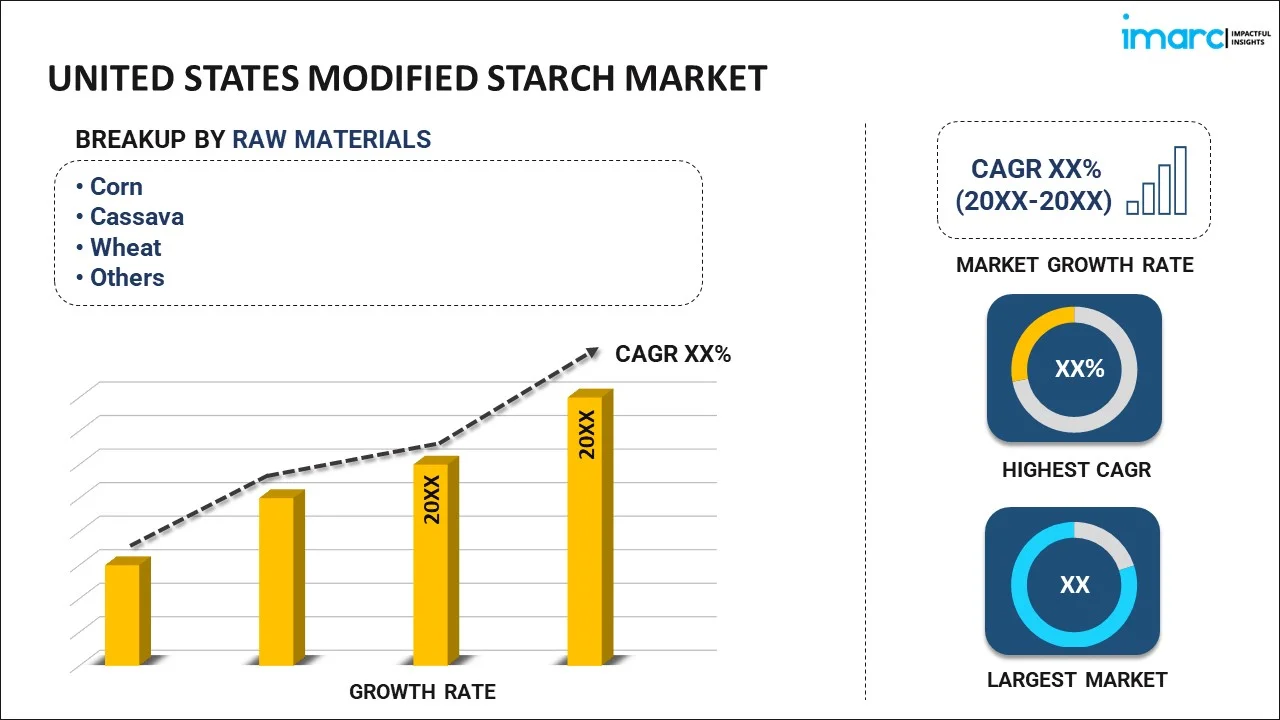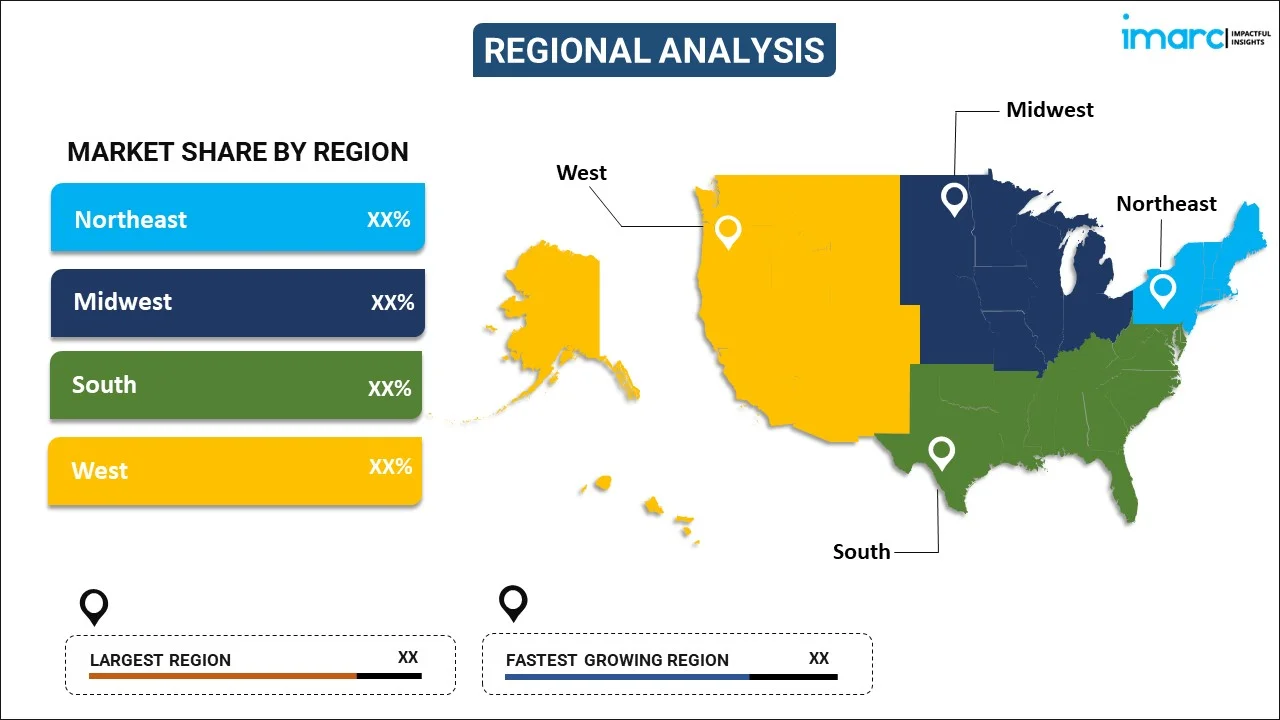
United States Modified Starch Market Report by Raw Material (Corn, Cassava, Wheat, Potato, and Others), Type (Starch Esters and Ethers, Resistant, Cationic, Pre-Gelatinized, and Others), Function (Thickeners, Stabilizers, Binders, Emulsifiers, and Others), Application (Food and Beverages, Animal Feed, Paper, Pharmaceuticals, Textiles, and Others), and Region 2025-2033
Market Overview:
United States modified starch market size reached USD 3.7 Billion in 2024. Looking forward, IMARC Group expects the market to reach USD 5.3 Billion by 2033, exhibiting a growth rate (CAGR) of 4.1% during 2025-2033. The expanding food and beverage industry, which utilizes modified starch for various applications, such as thickening agents, stabilizers, and emulsifiers, is driving the market.
|
Report Attribute
|
Key Statistics
|
|---|---|
|
Base Year
|
2024
|
|
Forecast Years
|
2025-2033
|
|
Historical Years
|
2019-2024
|
|
Market Size in 2024
|
USD 3.7 Billion |
|
Market Forecast in 2033
|
USD 5.3 Billion |
| Market Growth Rate 2025-2033 | 4.1% |
Modified starch refers to a chemically altered form of starch, a complex carbohydrate found in plants. The modification process involves treating starch to enhance its functionality and versatility in various industrial applications. Common modifications include changes in texture, stability, and viscosity achieved through physical, enzymatic, or chemical methods. These alterations improve the starch's performance in food production, pharmaceuticals, and other industries. Modified starches may exhibit enhanced resistance to heat, acid, or shear forces, making them suitable for a broader range of applications than native starch. In the food industry, they are often used as thickeners, stabilizers, or emulsifiers, contributing to improved texture, moisture retention, and shelf life in processed foods. Overall, modified starch plays a crucial role in meeting the diverse needs of modern industrial processes, offering a customizable solution to achieve specific product characteristics and performance attributes.
United States Modified Starch Market Trends:
The modified starch market in the United States is experiencing robust growth, primarily fueled by a confluence of factors. Firstly, the increasing demand for convenience foods and processed products has propelled the need for modified starch as a key ingredient in enhancing texture, stability, and shelf life. Moreover, the growing awareness and preference for healthier food alternatives have prompted manufacturers to turn to modified starch, as it allows for the reduction of fat content while maintaining desired product characteristics. In addition, the expansion of the food and beverage industry, coupled with the rising trend of clean-label products, has further driven the demand for modified starch as a natural and versatile ingredient. Furthermore, the burgeoning industrial applications of modified starch, such as in the textile, paper, and pharmaceutical industries, have contributed significantly to the market's momentum. The versatility of modified starch in meeting diverse industrial needs has amplified its adoption across various sectors. Additionally, the advancements in biotechnology and the development of innovative starch modification techniques have widened the scope of applications, fostering market growth. As a result, the modified starch market in the United States is poised for continuous expansion, driven by a complex interplay of consumer preferences, industrial requirements, and technological advancements.
United States Modified Starch Market Segmentation:
IMARC Group provides an analysis of the key trends in each segment of the market, along with forecasts at the country level for 2025-2033. Our report has categorized the market based on raw material, type, function, and application.
Raw Material Insights:

- Corn
- Cassava
- Wheat
- Potato
- Others
The report has provided a detailed breakup and analysis of the market based on the raw material. This includes corn, cassava, wheat, potato, and others.
Type Insights:
- Starch Esters and Ethers
- Resistant
- Cationic
- Pre-Gelatinized
- Others
A detailed breakup and analysis of the market based on the type have also been provided in the report. This includes starch esters and ethers, resistant, cationic, pre-gelatinized, and others.
Function Insights:
- Thickeners
- Stabilizers
- Binders
- Emulsifiers
- Others
The report has provided a detailed breakup and analysis of the market based on the function. This includes thickeners, stabilizers, binders, emulsifiers, and others.
Application Insights:
- Food and Beverages
- Animal Feed
- Paper
- Pharmaceuticals
- Textiles
- Others
A detailed breakup and analysis of the market based on the application have also been provided in the report. This includes food and beverages, animal feed, paper, pharmaceuticals, textiles, and others.
Regional Insights:

- Northeast
- Midwest
- South
- West
The report has also provided a comprehensive analysis of all the major regional markets, which include Northeast, Midwest, South, and West.
Competitive Landscape:
The market research report has also provided a comprehensive analysis of the competitive landscape. Competitive analysis such as market structure, key player positioning, top winning strategies, competitive dashboard, and company evaluation quadrant has been covered in the report. Also, detailed profiles of all major companies have been provided.
United States Modified Starch Market Report Coverage:
| Report Features | Details |
|---|---|
| Base Year of the Analysis | 2024 |
| Historical Period | 2019-2024 |
| Forecast Period | 2025-2033 |
| Units | Billion USD |
| Scope of the Report | Exploration of Historical and Forecast Trends, Industry Catalysts and Challenges, Segment-Wise Historical and Predictive Market Assessment:
|
| Raw Materials Covered | Corn, Cassava, Wheat, Potato, Others |
| Types Covered | Starch Esters and Ethers, Resistant, Cationic, Pre-Gelatinized, Others |
| Functions Covered | Thickeners, Stabilizers, Binders, Emulsifiers, Others |
| Applications Covered | Food and Beverages, Animal Feed, Paper, Pharmaceuticals, Textiles, Others |
| Regions Covered | Northeast, Midwest, South, West |
| Customization Scope | 10% Free Customization |
| Post-Sale Analyst Support | 10-12 Weeks |
| Delivery Format | PDF and Excel through Email (We can also provide the editable version of the report in PPT/Word format on special request |
Key Questions Answered in This Report:
- How has the United States modified starch market performed so far and how will it perform in the coming years?
- What has been the impact of COVID-19 on the United States modified starch market?
- What is the breakup of the United States modified starch market on the basis of raw material?
- What is the breakup of the United States modified starch market on the basis of type?
- What is the breakup of the United States modified starch market on the basis of function?
- What is the breakup of the United States modified starch market on the basis of application?
- What are the various stages in the value chain of the United States modified starch market?
- What are the key driving factors and challenges in the United States modified starch?
- What is the structure of the United States modified starch market and who are the key players?
- What is the degree of competition in the United States modified starch market?
Key Benefits for Stakeholders:
- IMARC’s industry report offers a comprehensive quantitative analysis of various market segments, historical and current market trends, market forecasts, and dynamics of the United States modified starch market from 2019-2033.
- The research report provides the latest information on the market drivers, challenges, and opportunities in the United States modified starch market.
- Porter's five forces analysis assist stakeholders in assessing the impact of new entrants, competitive rivalry, supplier power, buyer power, and the threat of substitution. It helps stakeholders to analyze the level of competition within the United States modified starch industry and its attractiveness.
- Competitive landscape allows stakeholders to understand their competitive environment and provides an insight into the current positions of key players in the market.
Need more help?
- Speak to our experienced analysts for insights on the current market scenarios.
- Include additional segments and countries to customize the report as per your requirement.
- Gain an unparalleled competitive advantage in your domain by understanding how to utilize the report and positively impacting your operations and revenue.
- For further assistance, please connect with our analysts.
 Inquire Before Buying
Inquire Before Buying
 Speak to an Analyst
Speak to an Analyst
 Request Brochure
Request Brochure
 Request Customization
Request Customization




.webp)




.webp)












